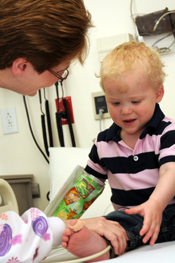Goodbye to the bubble
Medical researcher John Cunningham’s stem-cell–transplant technique gives others a chance at a normal life to a child with a rare immune disorder.
By John Otrompke
Photography by David Christopher
Cameron Dykstra was four months old when he came to the University of Chicago Medical Center in October 2007. He had what John Cunningham, professor of pediatrics, physiology, and stem-cell research, calls “profound diarrhea” related to a fungal infection in his gastrointestinal tract. Ordinarily diarrhea like that “never happens in children,” Cunningham says. When the doctors examined the boy’s blood counts and administered genetic tests, they diagnosed him with Severe Combined Immunodeficiency Syndrome (SCID), a genetic condition in which babies are born with little or no immune system.
 Diagnosed at four months with a rare immune disorder, Cameron Dykstra underwent a stem-cell–transplant technique developed by Chicago pediatrician John Cunningham.
Diagnosed at four months with a rare immune disorder, Cameron Dykstra underwent a stem-cell–transplant technique developed by Chicago pediatrician John Cunningham.Patients like Cameron have a better chance of recovering from SCID than in the 1970s, when The Boy in the Plastic Bubble aired on TV, thanks in part to a stem-cell transplant technique that Cunningham helped develop. “The true gold standard for the treatment of SCID,” he says, “is a stem-cell transplant with a brother or sister donor”—the patient’s closest genetic relative. “That works in more than 95 percent of children with SCID.”
When patients have no siblings from whom to draw stem cells, however, the situation becomes complicated. “A donation from parents”—who offer only a 50 percent genetic match for their children—“or from a matched unrelated donor works in approximately 60 percent of children,” says Cunningham. An Ireland native and expert in childhood cancers and blood disorders, he earned an MD at University College in Dublin and came to Chicago in 2006 as section chief of pediatric hematology/oncology at Comer Children’s Hospital. Stem cells from nonsibling donors, he says—even matched donors—can precipitate infection and rejection, resulting in an illness called graft-versus-host disease, which causes the new immune system to attack the patient’s body.
To combat these problems, in the late 1990s and early 2000s Cunningham, then a researcher at St. Jude Children’s Research Hospital in Memphis, helped design a new approach to purifying parent stem cells before transplantation. Physicians harvest the stem cells, then put them through a filtration device that isolates only those cells needed for transplant. “The technique seems to be about 80 percent effective,” Cunningham says. The purification has meant a four- or five-fold reduction in the risk of severe graft-versus-host disease and has made bone-marrow transplants from a biological parent an option for any child.
Since arriving at Chicago, Cunningham has treated about 15 children using the stem-cell purification process, including Cameron Dykstra. Five months after a successful transplant—an only child, he received stem cells from his father’s bone marrow—Cameron left the hospital in March 2008 with a functioning immune system. Since then he’s continued to fare well, coming in for regular check-ups and follow-up treatments.
Meanwhile, Cunningham’s stem-cell research continues. With Chicago geneticist Harinder Singh, he studies the chemical signals that guide the development and differentiation of blood-forming stem cells. Understanding the transcription factors that regulate normal development will help them decipher the disruptive mechanisms that can lead to disorders like leukemia.
Cunningham also continues to refine his stem-cell–transplant technique and investigate ways it might be applied to other diseases. With President Barack Obama’s March decision to lift the ban on federal funding for embryonic stem-cell research, scientists will be able to compare the properties of embryonic stem cells with stem cells extracted from adult cells.
Return to top